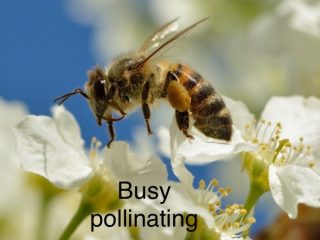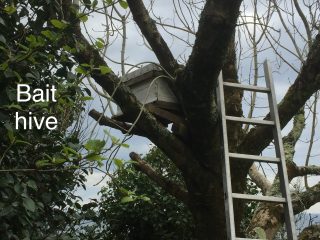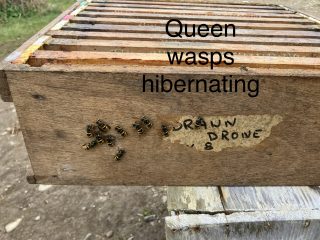Colin Rees explains how bees, and bee keepers, are gearing up for spring
As I write this month’s blog, I am looking out of the window at a lovely sunny day – so tempting for the bees (and me!) to think that spring is on the way. On checking, though, I see the temperature is barely 6º, which, with a brisk N/NE wind blowing in, actually feels more like 2º or 3º.
As a result, most bees are staying put in their hives until either the wind drops or the temperature rises. It is in such weather and temperatures that one can move hives within an apiary without the loss of bees. Nonetheless, I have seen the occasional bee in my garden over the past two weeks or so when the temperatures were similar to today, though the most such bees would be able to achieve would be collection of water to dilute their stores so that they could feed their young, limited collection of pollen and the voiding of their faeces. Having said that, though, most hives have been bringing in pollen over the past month, which means there is a lot going on inside the hive – increased rate of egg-laying by the queen and increased feeding of the brood by the workers. In fact, all my colonies are looking very strong for this time of year.
 When bees are placed in a hive for the first time (either as a swarm or when bought from another beekeeper or bee supplies shop) the first thing they do is orientate to the location of their new hive.
When bees are placed in a hive for the first time (either as a swarm or when bought from another beekeeper or bee supplies shop) the first thing they do is orientate to the location of their new hive.
This can be likened to setting up a ‘satnav’ to identify one’s home location. Once the bees have done this, whenever they leave the hive to forage they will always return to this same location. As a result, if I were to move their hive 3 feet or more away from the original site, the bees which are out foraging would be unable to find the hive in its new location on their return home. They would always return to the original site, even if the hive was only 3 feet away! However, if I were to move their hive to a new site which was over 3 miles away, they would realise on emerging from the hive that the surroundings were unfamiliar and would re-orientate to the new location. This is because bees tend to forage within a mile or perhaps 1.5 miles of their hive, as this is the maximum that allows them to bring back a forage crop worth collecting, and they become familiar with the landmarks within that area. If they foraged (as they can do if needs must) over a distance of, say, 5 miles, they would not have enough energy to complete the flight home without utilising some of the nectar they had collected to give them that little extra bit of energy necessary to complete the trip. This would be very inefficient and result in a smaller payload of stores being returned to the hive, and as we all know bees are certainly not inefficient! By moving a hive over 3 miles away from its original site, we are reducing the likelihood of the bees flying over territory which is familiar to them (over 1.5 miles from the hive), and so they return to the new site. If, when foraging, they flew over landmarks which were familiar to them then they would return to the original site of their hive – but the hive would no longer be there, as it has been moved away, the bees would cluster at the hive-less site and, if unnoticed, would likely die!
So why this explanation of foraging and orientation? Well, last summer I tempted two swarms into two of my many bait hives at home – one is in a tree in the apiary, the other is on a garage roof, remote from the apiary. Because of other demands on my time last summer, I never actually got round to moving the swarms into my apiary, so they have spent the remainder of last year and all winter in their lofty locations – which makes it virtually impossible to manage them and inspect them as I do with some colonies placed at ground level in the apiary. They needed to be moved – and this recent weather has been ideal for me to do this.
 Remember, during the winter, bees spend most of their time within the hive, rarely venturing out because of the cold or the rain.
Remember, during the winter, bees spend most of their time within the hive, rarely venturing out because of the cold or the rain.
By moving them at this time of year, and blocking their entrance with a removable block, then by the time they have cleared that blockage from the entrance, looked at the weather and decided to stay indoors anyway, when eventually they are able to fly again, they will realise they are in a new location and orientate to the new site. So I have blocked off their entrance with a really tight wad of grass which prevents their immediate egress. Over a few days, the grass will dry out and the bees will remove it, this interruption to their flying prompting them to realise things have changed. The additional thing in favour of success with this manoeuvre is that at this time of year the colony has fewer and fewer flying bees but many newly hatched and what are termed “winter” bees. These latter are the bees that have built up their fat-bodies during the autumn to enable them to survive the long winter months inside the hive without the need to forage. Once these bees have died off and the newly hatched bees start to progress towards foraging duties, orientation to the hive is a pre-requisite and therefore no flying bees will return to the tree or the garage roof because these sites are not known to them.
So, how to start the new beekeeping season by finishing off chores from last season? I have finally removed my autumn supers from three hives in one of my out-apiaries! There was no rush realIy because if there had been any honey in them and the bees needed it then they could have accessed it. In the event, the supers were empty – at least of honey – so I gave them all a feed of fondant.

But whilst loading the supers into the car, I noticed a bunch of queen wasps in hibernation on the wall of one of them!
Needless to say, they won’t be building nests this year!!I have been doing other things, as you know – cleaning and sterilising equipment, making fondant (which some colonies are getting through very rapidly!) and generally planning for the new season ahead.
Over the winter months, beekeepers can generally expect anything from a norm of 10% to up to 30% losses or even more, depending on circumstances but so far I appear to have been lucky – or my approach to beekeeping in a sustainable way is paying off. Mind you, winter is not over yet – chickens and eggs and all that!

The new season being almost here for the bees also means it’s a new season for the Asian Hornet.
The time of year is approaching when Asian Hornet queens emerge from hibernation and start to build their primary nests, so I will be putting out some monitoring traps to see if there are any around my neck of the woods (though I’m hoping for a negative on this!). The queens need carbohydrate to build up and give them energy and trials have shown that beer is the paying off substance Asian Hornets find most attractive. So I shall be priming my monitoring traps with some dark beer to see what happens (I’d better taste it first to make sure it’s alright!) – you might care to try the same. There are simple plans on the internet for building home-made monitoring traps using old lemonade bottles – you could do worse than to try making one yourself and do your bit to keep this horrendous exotic pest from establishing in the UK.
Hopefully by next month the weather will allow of some hands-on beekeeping and I will have more to report.
Colin Rees 01872 501313 07939 971104 colinbeeman@aol.com

